1976 CHEVROLET VEGA tire type
[x] Cancel search: tire typePage 43 of 87
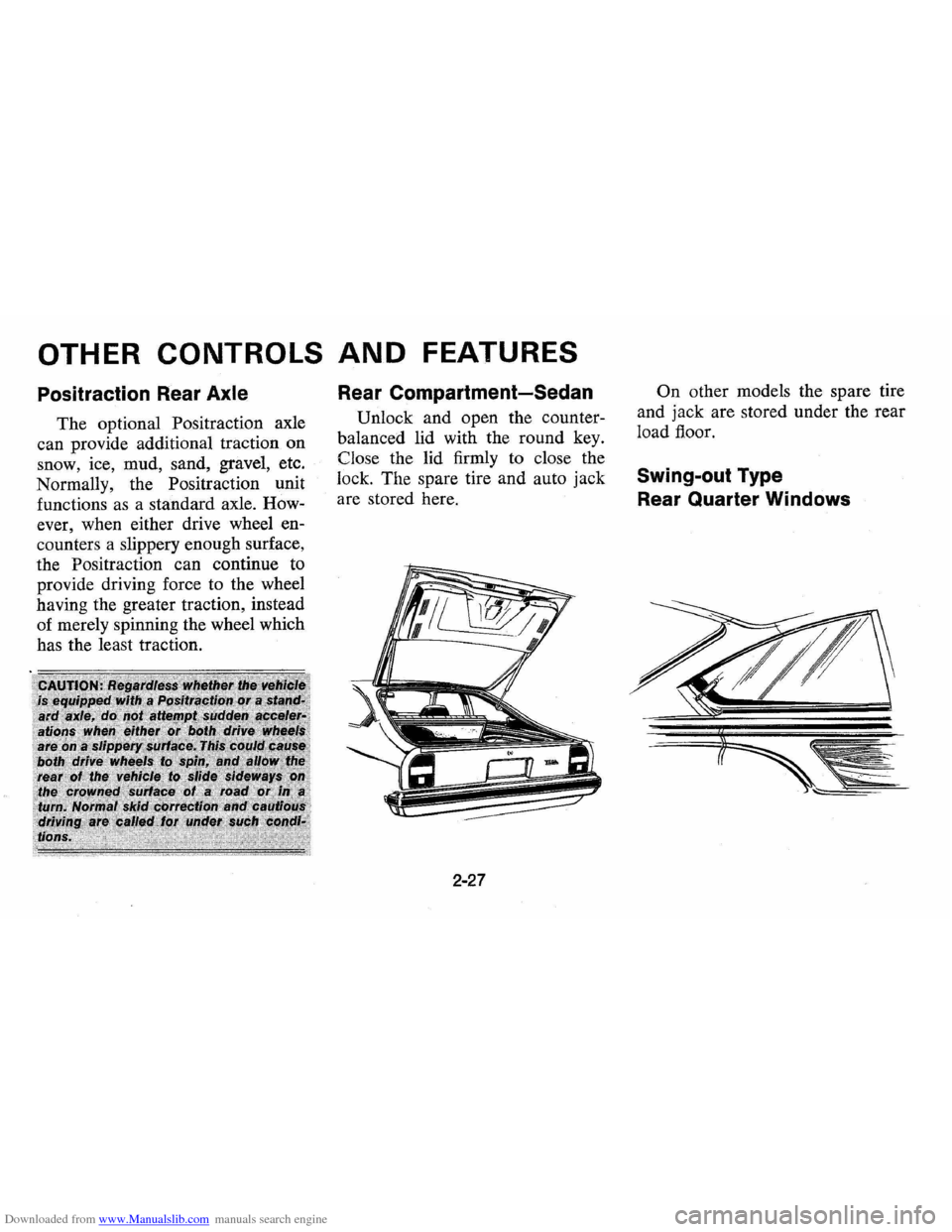
Downloaded from www.Manualslib.com manuals search engine OTHER CONTROLS AND FEATURES
Positraction Rear Axle
The optional Positraction axle
can provide additional traction
on
snow, ice, mud, sand, gravel, etc.
Normally, the
Positraction unit
functions as a standard axle. How
ever, when either drive wheel en
counters a slippery enough surface,
the
Positraction can continue to
provide driving forc'e to the wheel
having the greater traction, instead
of merely spinning the wheel which
has the least traction.
Rear Compartment-Sedan
Unlock and open the counter
balanced lid with the round key.
Close the lid firmly to close the
lock. The spare tire and auto jack
are stored here.
2-27
On other models the spare tire
and jack are stored under the rear
load floor.
Swing-out Type
Rear Quarter Windows
Page 52 of 87
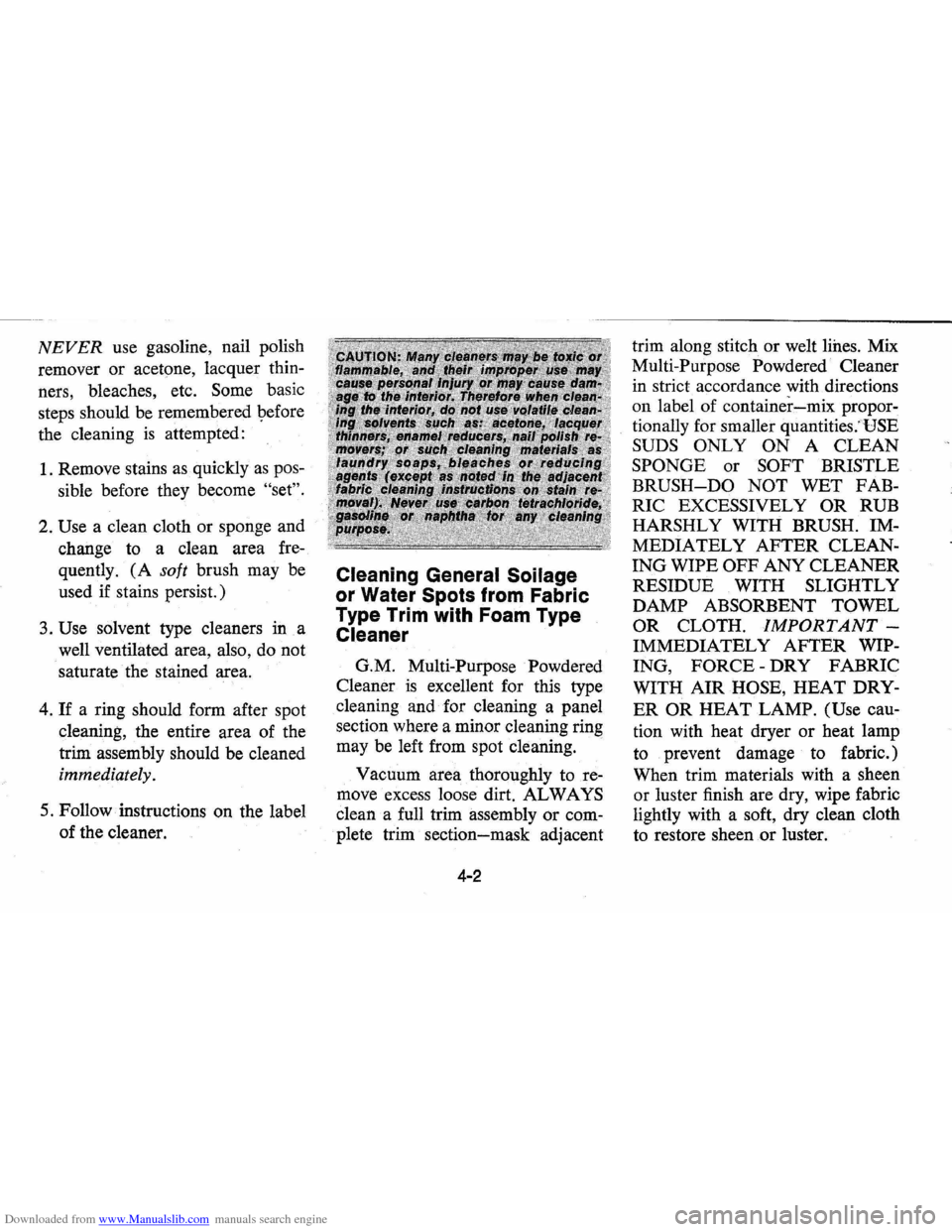
Downloaded from www.Manualslib.com manuals search engine NEVER use gasoline, nail polish
remover or acetone, lacquer
thin
ners, bleaches, etc. Some basic
steps should be remembered
l;>efore
the cleaning is attempted:
1. Remove stains as. quickly as pos
sible before they become "set".
2. Use a clean cloth or sponge and
change to a clean area
fre
quently. (A soft brush may be
used if stains persist.)
3. Use solvent type cleaners in a
well ventilated area, also, do not
saturate the stained area.
4.
If a ring should form after spot
cleaning, the entire area of the
trim assembly should be cleaned
immediately.
5. Follow instructions on the label
of the cleaner.
Cleaning General Soilage
or Water Spots from Fabric
Type Trim with Foam Type
Cleaner
G.M. Multi-Purpose Powdered
Cleaner
is excellent for this type
cleaning and for cleaning a panel
section where a minor cleaning ring
may be left from spot cleaning.
Vacuum area thoroughly to
re
move excess loose dirt. ALWAYS
clean a full trim assembly or com
plete trim section-mask adjacent
4-2
trim along stitch or welt liiles. Mix
Multi-Purpose Powdered Cleaner
in strict accordance with directions
on label of container
___ mix propor-
tionally for smaller
quantities/USE
SUDS ONLY ON A CLEAN
SPONGE or SOFT BRISTLE
BRUSH-DO NOT
WET FAB
RIC EXCESSIVELY OR RUB
HARSHL
Y WITH BRUSH. IM
MEDIATELY AFTER CLEAN
ING WIPE OFF ANY CLEANER
RESIDUE WITH SLIGHTLY
DAMP ABSORBENT TOWEL
OR CLOTH.
IMPORTANT
IMMEDIATELY AFTER WIP
ING, FORCE -DRY FABRIC
WITH AIR
HOSE, HEAT DRY
ER OR HEAT LAMP. (Use cau
tion with heat dryer or heat lamp
to prevent damage to fabric. )
When trim materials with a sheen
or luster finish are dry, wipe fabric
lightly with a soft, dry clean cloth
to restore sheen or luster.
Page 53 of 87

Downloaded from www.Manualslib.com manuals search engine Spot Cleaning Fabric Type
Trim Materials with
Solvent
Type Cleaner
Before attempting to remove
spots or stains from fabric, deter
mine
as accurately as possible the
nature and age of the spot or stain.
Some spots or stains can be re
moved satisfactorily with water or
mild soap solution (refer to ac
companying
"Removal of Specific
Stains"). For best results, spots or
stains should be removed
as soon
as possible. Some types of stains
or soilage such
as lipstick, some
inks, certain types of grease etc.,
are extremely difficult and,
in some
cases, impossible to completely re
move. When cleaning this type of
stain or soilage, care must be taken
not to enlarge the soiled area.
It is
sometimes more desirable to have
a small stain than an enlarged stain
as a result of careless cleaning.
G.M.
Spot Lifter (Solvent Type)
is excellent for spot cleaning stains
containing grease, oil or fats from
fabric type trim. Excess stain
should be gently scraped off trim
material with a clean DULL knife
or scraper.
USE VERY LITTLE
CLEANER, light pressure, and
clean cloths (preferably cheese
cloth). Cleaning action should be
from outside of stain FEATHER
ING towards center of stain and
constantly changing· to a clean sec
tion of cloth.
When stain is cleaned
from · fabric, immediately dry area
with an· air
hose, heat dryer or heat
l~mp to help prevent a cleaning
flng (use caution with heat dryer
or heat
lamp to prevent damage to
fabric material).
If a ring forms,
immediately repeat the
. cleaning
operation over a slightly larger
area with special emphasis on
FEATHERING towards center of
area.
If ring still persists, mark
off adjacent trim sections and clean
4-3
entire affected trim panel sectIOn
with G.M. Multi-Purpose Powdered
Cleaner
as previously described
under
"Cleaning General Soilage
or Water
Spots with Foam Type
Cleaner."
Removal of Specific Stains
Grease or Oil Stains-Includes
grease, oil, butter, margarine shoe
polish, coffee with cream,
ch~wing
gum, cosmetic creams, vegetable
oils, wax crayon, tar and asphalts.
Carefully scrape off excess stain;
then use Spot Lifter (Solvent
Type) as previously described.
Shoe polish, wax crayons, tar and
asphalts
will stain if allowed to
remain on trim; they should be
removed
as soon as possible-use
caution
as cleaner will dissolve
them and may cause them to bleed.
Non-Greasy Stains-Includes cat
sup, coffee (black), egg, fruit, fruit
Page 56 of 87
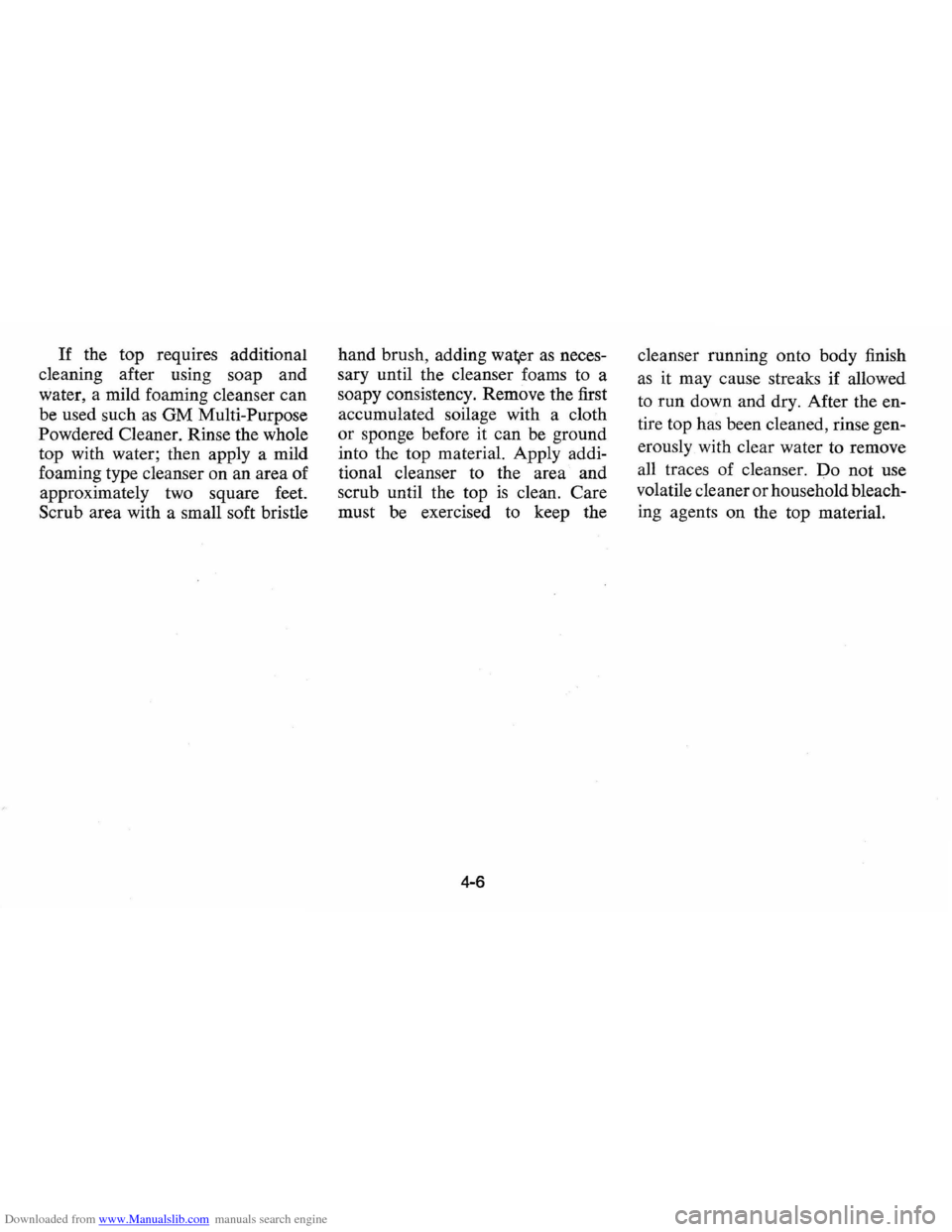
Downloaded from www.Manualslib.com manuals search engine If the top requires additional
cleaning after using soap and
water, a mild foaming cleanser can
be used such
as GM Multi-Purpose
Powdered Cleaner. Rinse the whole
top with water; then apply a mild
foaming type cleanser on an area of
approximately two square feet.
Scrub area with a small soft bristle hand
brush, adding
wa~er as neces
sary until the cleanser foams to a
soapy consistency. Remove the first
accumulated soilage with a cloth
or sponge before it can be ground
into the top material. Apply addi
tional cleanser to the area and
scrub until the top
is clean. Care
must be exercised to keep the
4-6
cleanser running onto body finish
as it may cause streaks if allowed
to run down and dry. After the en
tire top has been cleaned, rinse gen
erously with clear water to remove
all traces of cleanser. Do not use
volatile cleaner or household bleach
ing agents on the top material.
Page 57 of 87
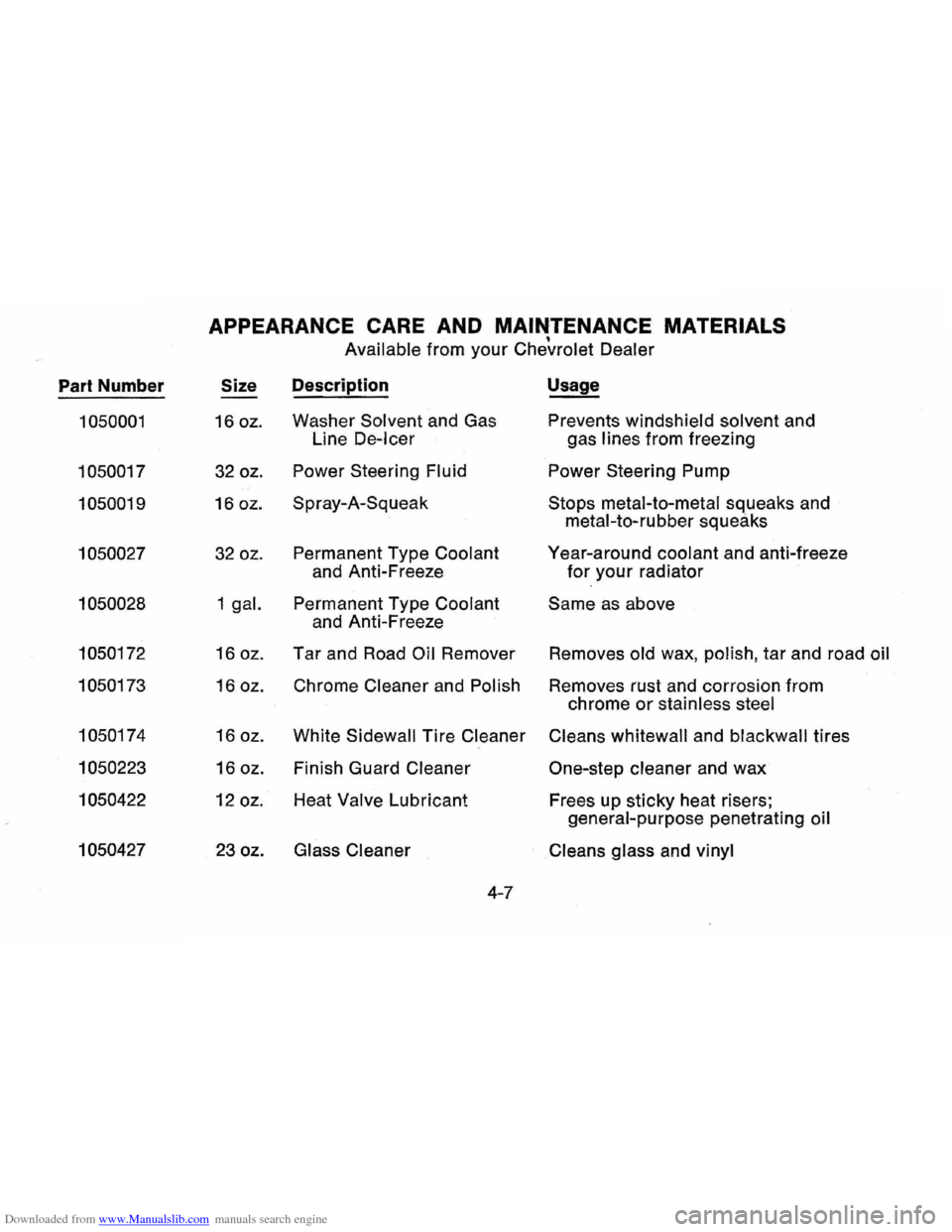
Downloaded from www.Manualslib.com manuals search engine APPEARANCE CARE AND MAINTENANCE MATERIALS • Available from your Chevrolet Dealer
Part Number Size Description Usage
1050001 16 oz. Washer Solvent and
Gas Prevents windshield solvent and
Line
De-leer gas lines from freezing
1050017 32 oz. Power
Steering Fluid Power Steering Pump
1050019 16 oz. Spray-A-Squeak Stops metal-to-metal squeaks and
metal-to-rubber squeaks
1050027 32 oz. Permanent
Type Coolant Year-around coolant and anti-freeze
and Anti-Freeze
for your radiator
1050028 1 gal. Permanent Type Coolant Same as above
and Anti-Freeze
1050172 16 oz. Tar and Road Oil Remover Removes old wax, polish, tar and road oil
1050173
16 oz. Chrome Cleaner and Polish Removes rust and corrosion from
chrome
or stainless steel
1050174
16 oz.
White Sidewall Tire Cleaner Cleans whitewall and blackwall tires
1050223 16 oz. Finish Guard Cleaner One-step cleaner and wax
1050422 12 oz. Heat Valve Lubricant
Frees up sticky heat risers;
general-purpose penetrating oil
1050427 23 oz. Glass Cleaner
Cleans glass and vinyl
4 -7
Page 72 of 87
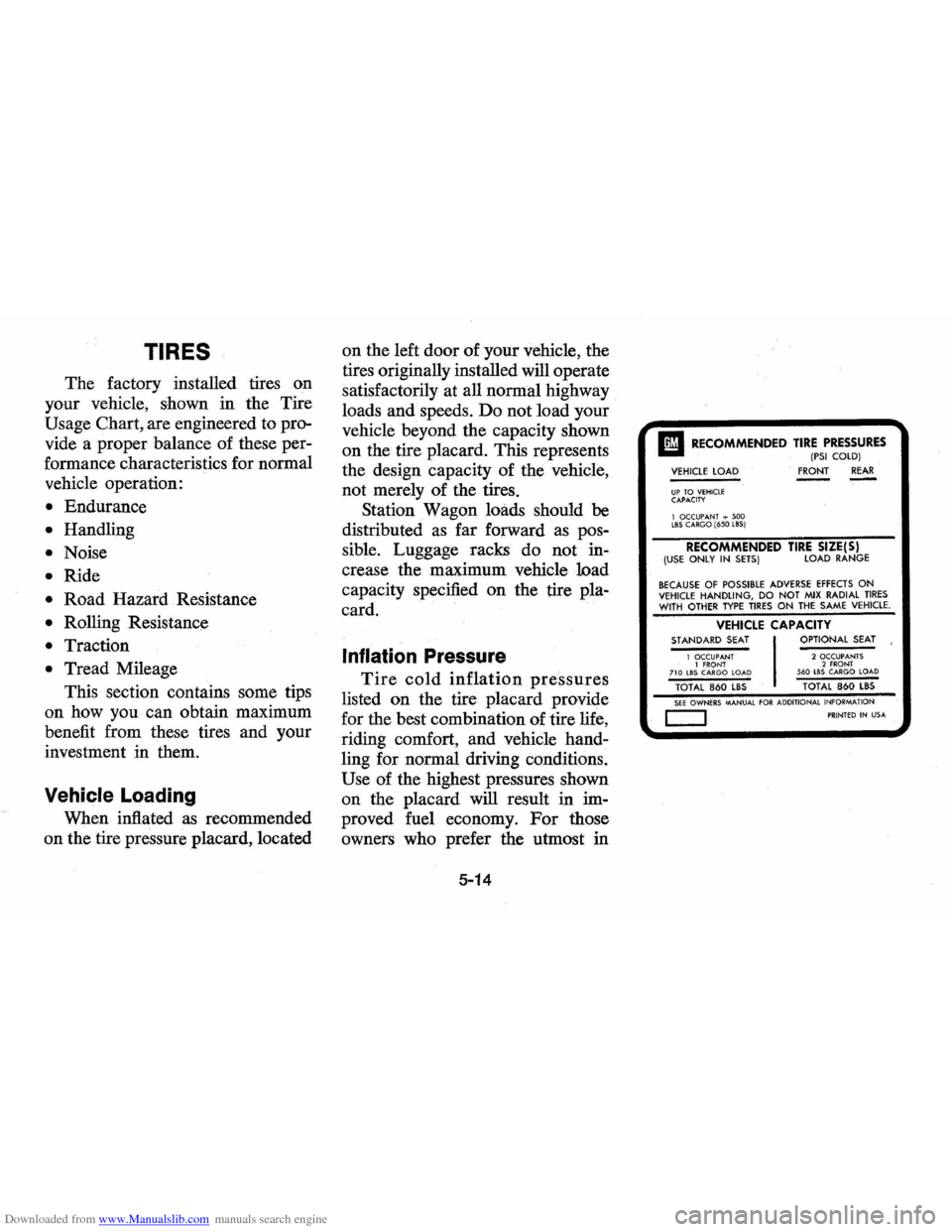
Downloaded from www.Manualslib.com manuals search engine TIRES
The factory installed tires on
your vehicle, shown in the Tire
Usage Chart, are engineered to pro
vide a proper balance of these per
formance characteristics for normal
vehicle operation:
• Endurance
• Handling
• Noise
• Ride
• Road Hazard Resistance
• Rolling Resistance
• Traction
• Tread Mileage
This section contains some tips
on how you can obtain maximum
benefit from these tires and your
investment in them.
Vehicle Loading
When inflated as recommended
on the tire pressure placard, located on
the left door of your vehicle,
the
tires originally installed will operate
satisfactorily at all normal highway
loads and speeds. Do not load your
vehicle beyond the capacity shown
on the tire placard. This represents
the design capacity of the vehicle,
not merely of the tires.
Station Wagon loads should
be
distributed as far forward as pos
sible. Luggage racks do not in
crease the maximum vehicle load
capacity specified on the tire pla
card.
Inflation Pressure
Tire cold inflation pressures
listed on the tire placard provide
for the best combination of tire life,
riding comfort, and vehicle hand
ling for normal driving conditions.
Use of the highest pressures shown
on the placard will result in
im
proved fuel economy. For those
owners who prefer the utmost in
5-14
II RECOMMENDED TIRE PRESSURES (PSI COlD) VEHICLE lOAD FRONT REAR ----UP TO VEHICLE CAPACITY
1 OCCUPANT + 500 lBS CARGO (650 lBS)
RECOMMENDED TIRE SIZE(S) (USE ONLY IN SETS) LOAD RANGE
BECAUSE OF POSSIBLE ADVERSE EFFECTS ON VEHICLE HANDLING, DO NOT MIX RADIAL TIRES WITH OTHER TYPE TIRES ON THE SAME VEHICLE.
VEHICLE CAPACITY STANDARD SEAT OPTIONAL SEAT
1 OCCUPANT 2 OCCUPANTS 1 fRONT 2 FRONT 710 lBS CARGO LOAD 560 LBS CARGO LOAD TOTAL 860 lBS TOTAL 860 lBS SEE OWNERS MANUAL FOR ADDITIONAL
INFORMATION
c::J PRINTED IN USA
Page 74 of 87
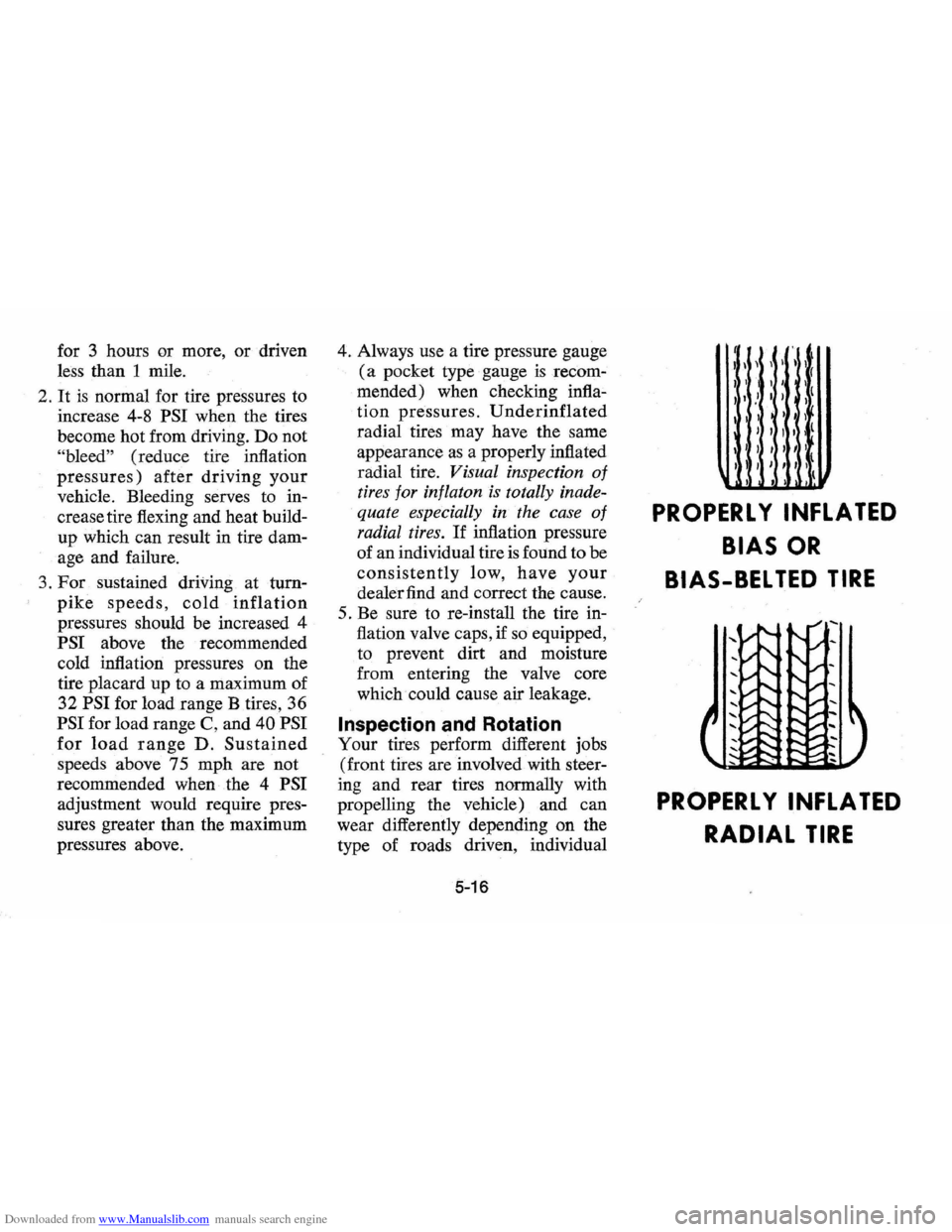
Downloaded from www.Manualslib.com manuals search engine for 3 hours or more, or driven
less than 1 mile.
2 .
It is normal for tire pressures to
increase 4-8
PSI when the tires
become hot from driving. Do not
"bleed" (reduce tire inflation
pressures) after driving your
vehicle. Bleeding serves to in
crease tire flexing and heat build
up which can result in tire dam
age and failure.
3. For sustained driving at turn
pike speeds, cold inflation
pressures should be increased 4
PSI above the recommended
cold inflation pressures on the
tire placard up to a maximum of
32
PSI for load range Btires, 36
PSI for load range C, and 40 PSI
for load range D. Sustained
speeds above 75 mph are not
recommended when the 4
PSI
adjustment would require pres
sures greater than the maximum
pressures above.
4. Always use a tire pressure gauge
(a pocket type gauge is recom
mended) when checking
infla~
tion pressures. Underinflated
radial tires may have the same
appearance
as a properly inflated
radial tire.
Visual inspection of
tires for inflaton is totally inade
quate especially in the case
of
radial tires. If inflation pressure
of an individual tire
is found to be
consistently low, have your
dealer find and correct the cause.
5. Be sure to re-install the tire in
flation valve caps, if
so equipped,
to prevent dirt and moisture
from entering the valve core
which could cause air leakage.
Inspection and Rotation
Your tires perform different jobs
(front tires are involved with steer
ing and rear tires normally with
propelling the vehicle) and can
wear differently depending on the
type of roads driven, individual
5-16
1\ II(
" I I ,t " I' ,I
I' I I j , I I I
I I , I I I I
I I I I I I
I 1
PROPERL Y INFLATED
BIAS OR
BIAS-BEL TED TIRE
PROPERL Y INFLATED
RADIAL TIRE
Page 76 of 87
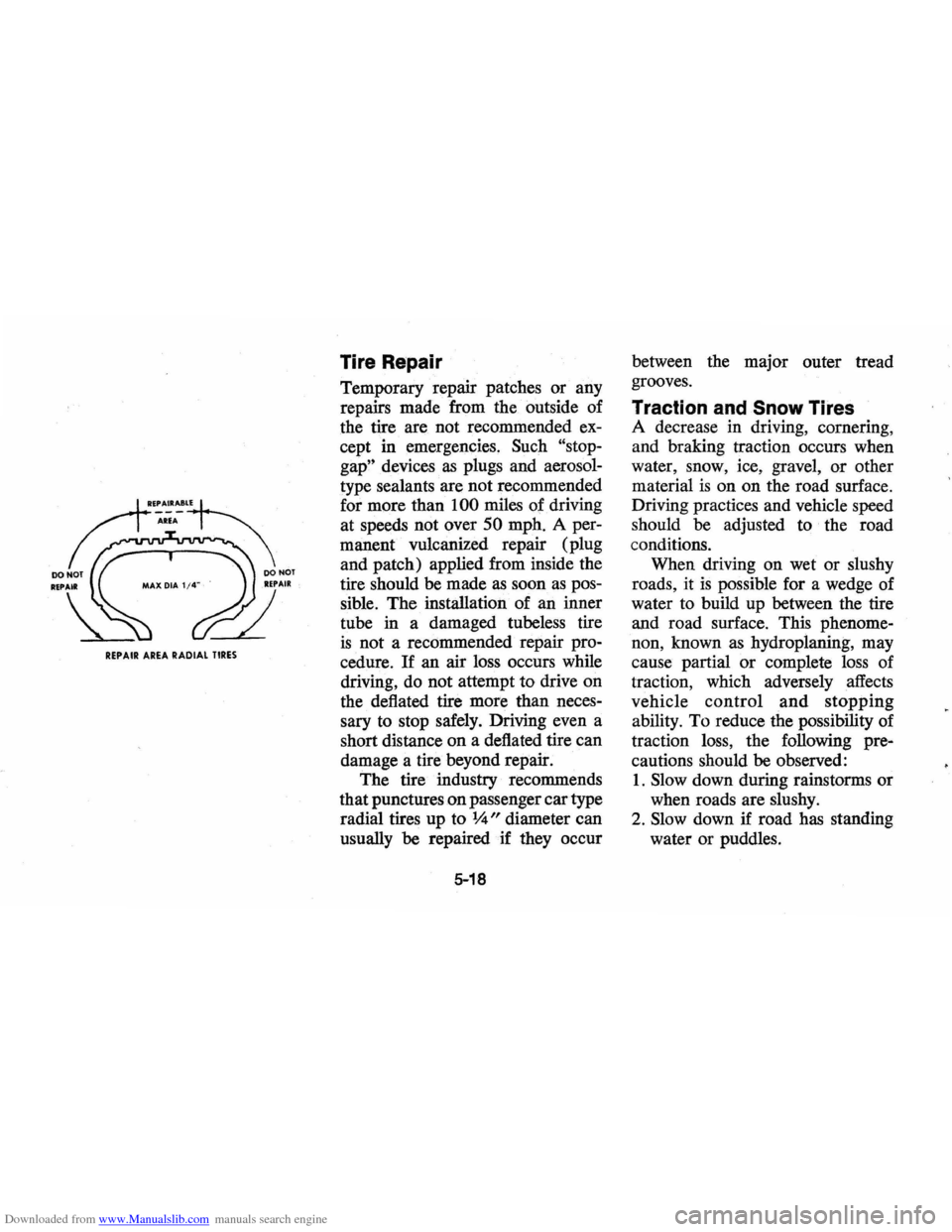
Downloaded from www.Manualslib.com manuals search engine a~~~
DO NOT DO NOT
w~ ~"" "." !d'"
REPAIR AREA RADIAL TIRES
Tire Repair
Temporary repair patches or any
repairs made from the outside of
the tire are not recommended ex
cept in emergencies. Such "stop
gap"
devices as plugs and aerosol
type sealants are not recommended
for more than
100 miles of driving
at speeds not over
50 mph. A per
manent vulcanized repair (plug
and patch) applied from inside the
tire should be made
as soon as pos
sible. The installation of an inner
tube in a damaged tubeless tire
is not a recommended repair pro
cedure.
If an air loss occurs while
driving, do not attempt
to drive on
the deflated tire more than neces
sary to stop safely. Driving even a
short distance on a deflated tire can
damage a tire beyond repair.
The tire industry recommends
that punctures
on passenger car type
radial tires up to
%" diameter can
usually be repaired if they occur
5-18
between the major outer tread
grooves.
Traction and Snow Tires
A decrease in driving, cornering,
and braking traction occurs when
water , snow, ice, gravel,
or other
material
is on on the road surface.
Driving practices and vehicle speed
should be adjusted to the road
conditions. When driving on wet or slushy
roads , it
is possible for a wedge of
water to build up between the tire
and road surface. This phenome
non, known
as hydroplaning, may
cause partial or complete loss of
traction, which adversely affects
vehicle
control and stopping
ability. To reduce the possibility of
traction loss, the following pre
cautions should
be observed:
1 .
Slow down during rainstorms or
when
roads are slushy.
2. Slow down if road has standing
water or
pUddles.